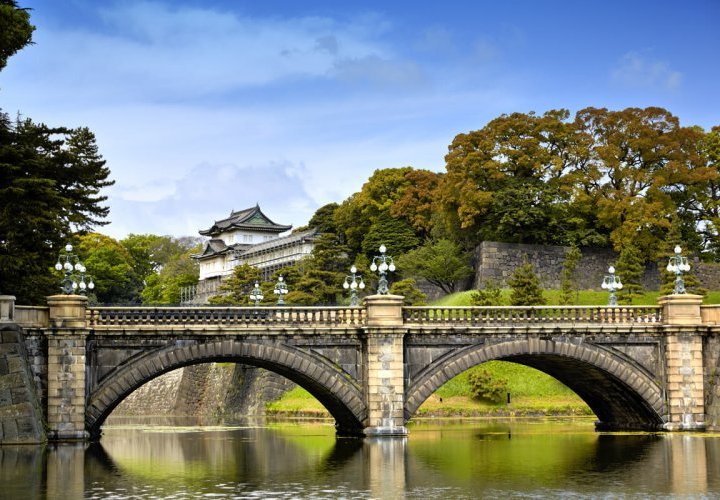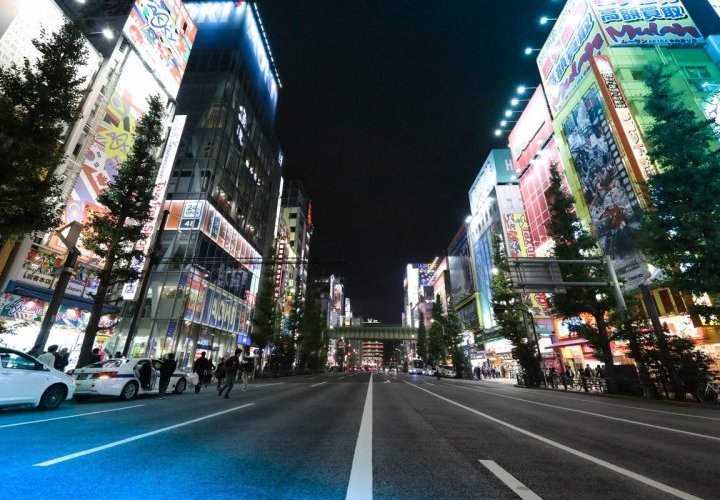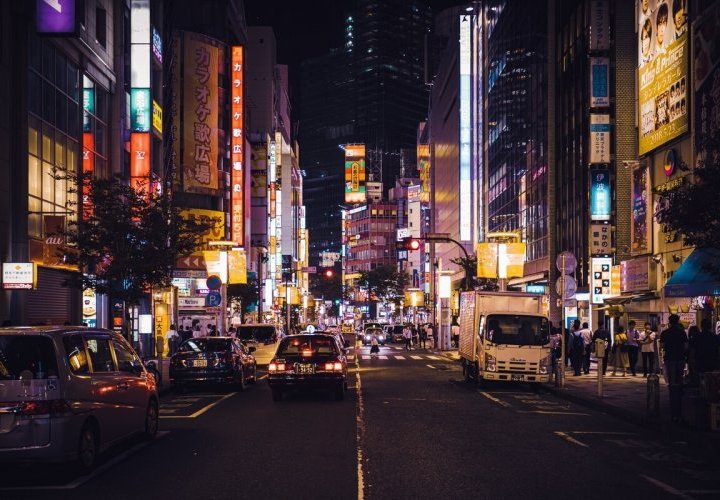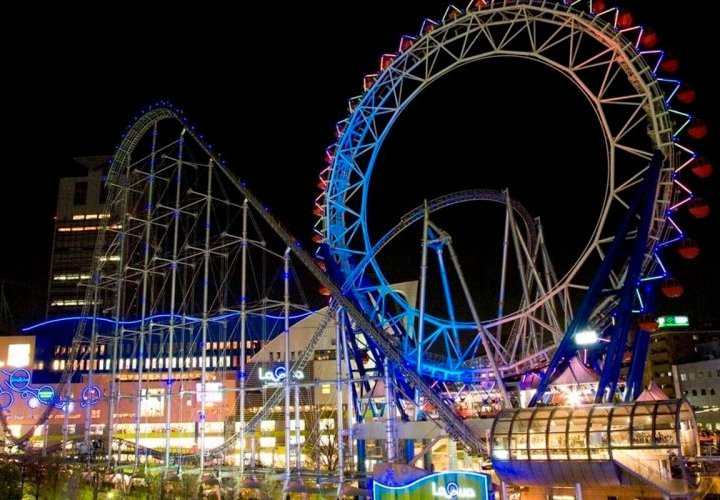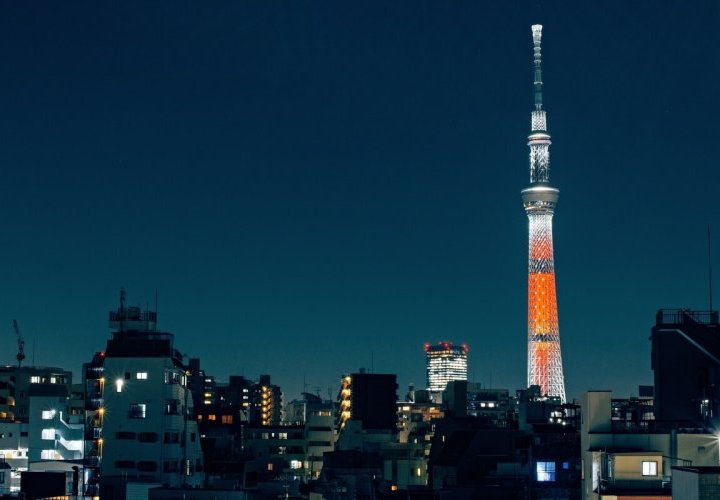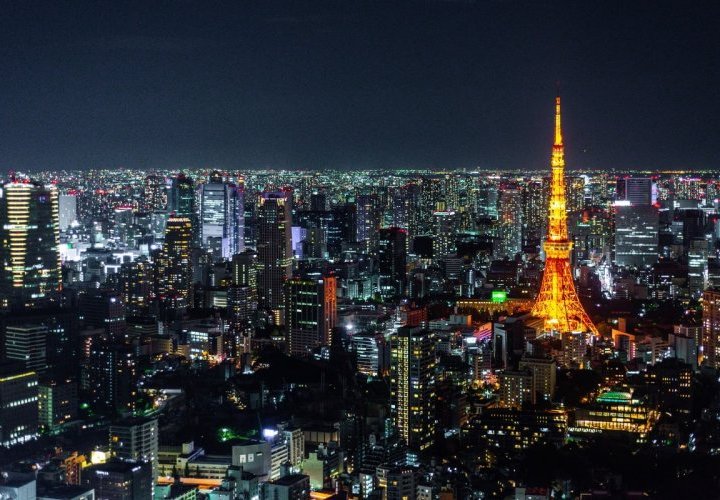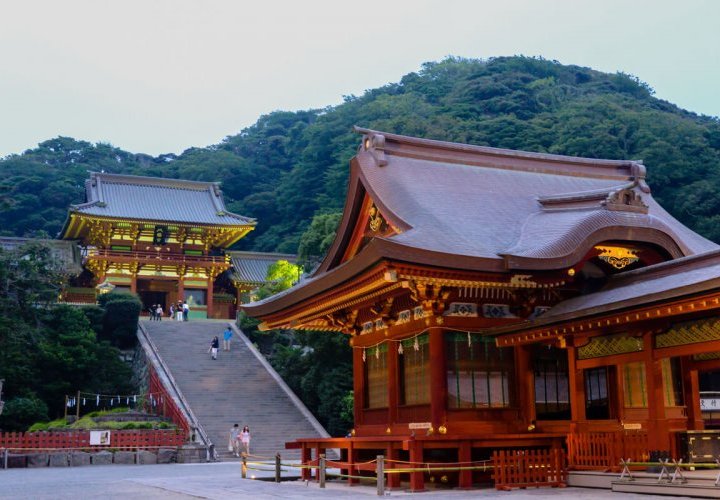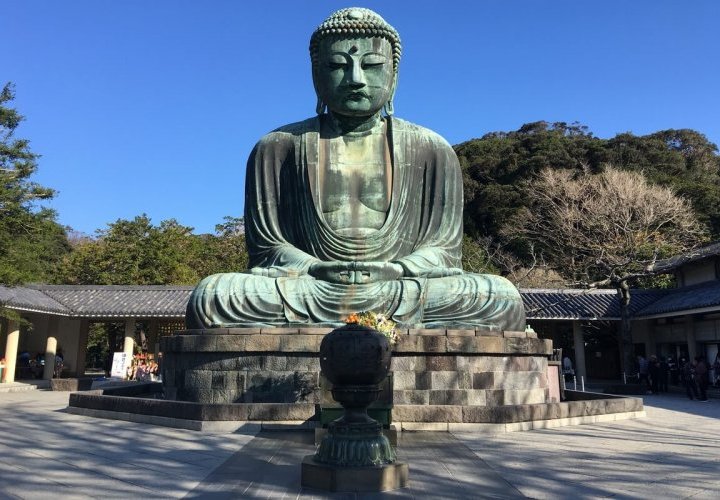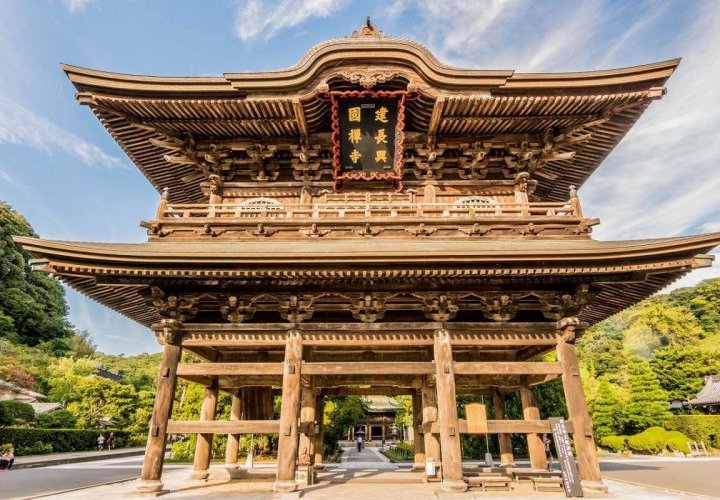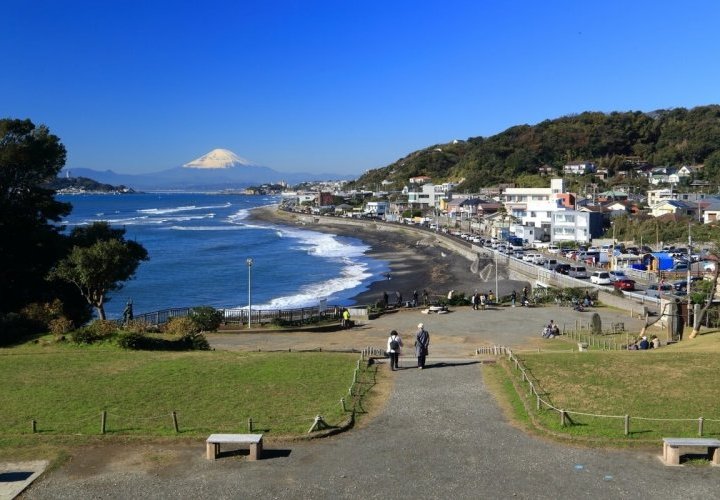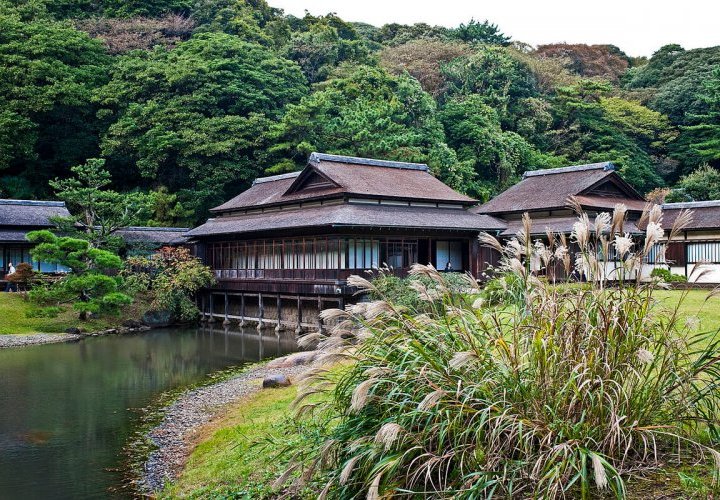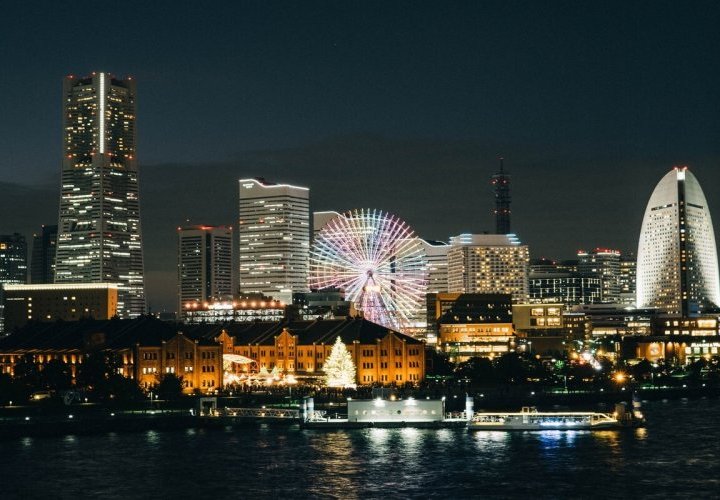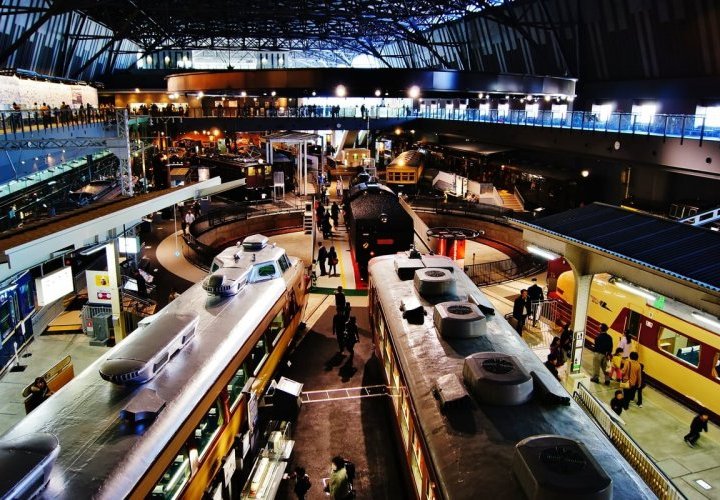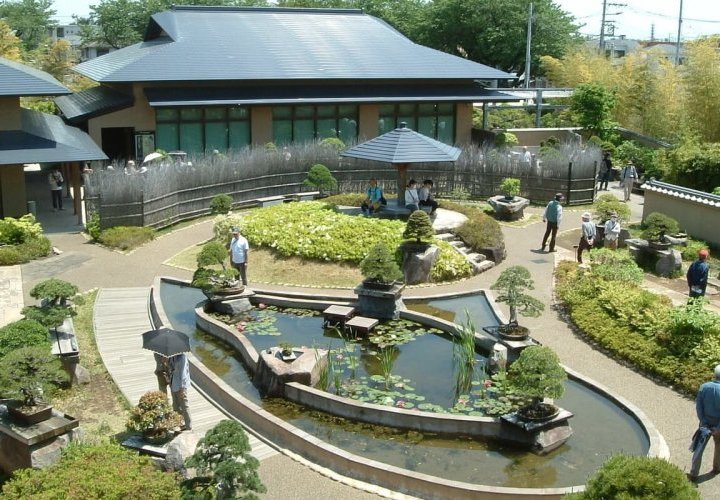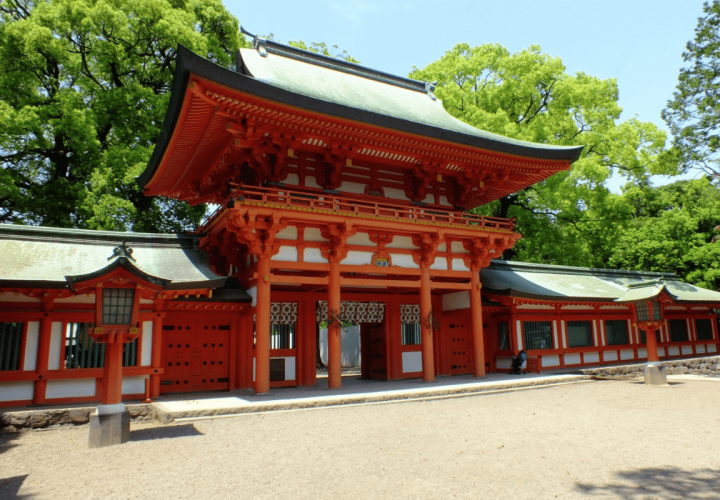Kanto region includes the Greater Tokyo Area and consists of seven prefectures: Gunma, Tochigi, Ibaraki, Saitama, Tokyo, Chiba, and Kanagawa. It is the most developed, urbanized, densely populated and industrialized part of Japan including the large metropolises of Tokyo and Yokohama. Its population (around 42,607,376 inhabitants) amounts to approximately one third of the total population of Japan.
Tokyo is the capital of Japan and one of the most populated cities in the world. Before 1868, Tokyo was known as Edo. From just a small castle town in the 16th century, Edo became the political centre of Japan when Tokugawa Ieyasu established his feudal government there in 1603. In 1868, the Emperor Meiji moved the capital from Kyoto to Edo, which was renamed Tokyo (“Eastern Capital”). more
Tokyo is the capital of Japan and one of the most populated cities in the world. Before 1868, Tokyo was known as Edo. From just a small castle town in the 16th century, Edo became the political centre of Japan when Tokugawa Ieyasu established his feudal government there in 1603. In 1868, the Emperor Meiji moved the capital from Kyoto to Edo, which was renamed Tokyo (“Eastern Capital”). more
Currently Tokyo is a dynamically modern metropolis covering more than 2,000 square kilometres and offering unforgettable experiences during the entire year.
TOURIST ATTRACTIONS IN TOKYO
Tokyo Imperial Palace
Tokyo Imperial Palace is located on the former site of Edo Castle and is the primary residence of the Emperor of Japan. It is located on a large area in the centre of Tokyo that contains buildings including the main palace, the private residences of the Imperial Family, an archive, museums and administrative offices and is surrounded by moats and massive stone walls. The inner grounds of the palace are generally not open to the public (excepting January 2 and February 23), but there are guided tours of the palace grounds (75 min.) offered daily during the rest of the year, although no buildings are entered.
Koishikawa Korakuen
Koishikawa Korakuen is one of Tokyo’s oldest and best Japanese gardens dating back to the 17th century. It is attractive throughout the year attempting to reproduce famous landscapes in miniature, using ponds, stones, trees and manmade hills, but it is especially beautiful in late November during the fall colour season and from mid-February through early April during the plum and cherry blossom seasons.
Akihabara
Akihabara is a district in central Tokyo that is famous for its electronics shops that line the main Chuo Dori street and the crowded side streets around Akihabara offering various items such as computers, TV sets, cameras, mobile phones, electronics parts and home appliances.
Ginza
The most popular upmarket shopping, dining and entertainment district of Tokyo, Ginza, boasts many department stores, boutiques, art galleries, restaurants, nightclubs and cafés. It is the area with the highest concentration of Western shops in Tokyo and one of the most expensive real estate in Japan.
Tokyo Dome City
Tokyo Dome City is an entertainment complex in central Tokyo including Tokyo Dome baseball stadium (the home stadium of Yomiuri Giants), an amusement park with various rides and entertainment facilities, LaQua spa (a popular relaxation oasis featuring real hot spring pools, saunas, relaxation space and various massage and beauty services), a variety of shops and restaurants and Tokyo Dome Hotel.
Tokyo State Guest House
Tokyo State Guest House or Akasaka Palace is one of the two state guesthouses of the Government of Japan (the other one is in Kyoto). The main building that is a Neo-Baroque style Western building has 15,000 square metres of floor space, and together with a smaller structure in Japanese style, occupies an area of 117,000 square metres. The palace that was originally built as the Imperial Palace for the Crown Prince in 1909 is currently included within the Akasaka Imperial Estate and serves to accommodate world leaders, diplomats and other guests of honour during their visits to Japan.
Tokyo National Museum
Tokyo National Museum is the oldest national museum in Japan and features one of the largest and best collections of art and archaeological artefacts of over 110,000 items. Originally established in 1972 at Yushima Seido Shrine, it was moved to its current location in Ueno Park a few years later. It is home to six separate buildings specializing in different types of art and exhibitions.
Tokyo Skytree
Tokyo Skytree is the tallest free-standing tower in the world reaching the height of 634 m and the second tallest structure in the world after the Burj Khalifa (829.8 m). It is a landmark of Tokyo and has two observations decks located at heights of 350 and 450 m that offer spectacular views over Tokyo city. Its construction started in 2008 and its public opening was in May 2012, allowing Tokyo Skytree to become the primary television and radio broadcast site for Kanto region and a popular photo object.
Asakusa
Asakusa is the centre of Tokyo's shitamachi that literally means “low city” where a more traditionally Japanese atmosphere survives. Its main attraction is Sensoji, a very popular Buddhist temple, built in the 7th century, but there are also other temples in Asakusa, as well as different festivals, such as the Sanja Matsuri.
Sensoji Temple
Sensoji is a Buddhist temple dedicated to the Kannon Bosatsu, the Bodhisattva of compassion in Asakusa. It is the oldest and one of the most colourful and popular temples of Tokyo. The temple was completed in 645 and is one of the most widely visited spiritual sites in the world. In the area of the temple, there is a five-story pagoda, Asakusa Shinto shrine and many shops with traditional goods along the Nakamise, a shopping street of over 200 metres. In order to reach the temple, the visitors first enter through the Kaminarimon (Thunder Gate), the outer of the two large entrance gates and the symbol of Asakusa and the entire city of Tokyo.
Edo-Tokyo Museum
Edo-Tokyo Museum established in 1993 is a museum of Tokyo’s history mostly during the Edo period. The permanent exhibition of the museum presents the past of Tokyo (known as Edo until 1869) from the Edo period to relatively recent decades offering the visitors the possibility to discover various aspects of earlier Tokyo, such as the way of life of people, Edo period architecture, cultural heritage, etc.
Ueno Park
Ueno Park is a spacious public park near Ueno Station. It was established in 1873 on the lands belonging to the former Kaneiji Temple, which used to be one of the city's largest and wealthiest temples. Currently Ueno Park is famous for many museums found on its grounds, especially Tokyo National Museum, National Museum of Western Art, Tokyo Metropolitan Art Museum and National Museum of Nature and Science. It is especially crowded in late March to early April when people gather to enjoy the view of the cherry blossoms.
Koishikawa Botanical Garden
Koishikawa Botanical Garden belongs to the nearby Tokyo University and is one of the most pleasant places for cherry blossom viewing in Tokyo. It dates back to 1684 when the 5th Tokugawa shogun, Tsunayoshi, established the Koishikawa Medicinal Herb Garden and exhibits and preserves around 4,000 plant species including camellias, maples, cherries, Japanese primroses, bonsai trees, and alpine plants. It also has a herbarium with 1.4 million specimens and a library with 20,000 books and journals.
Ameyoko
Ameyoko is a busy market street located next to Ueno Station. There are two theories on the etymology of Ameya: the first one is that the name came from “ameya” (candy shop), as candies were traditionally sold there; the second one relates that “Ame” stands for “America”, because a lot of American products used to be available there. Currently the market is home to over 180 shops selling various products such as fresh seafood, clothes, bags, cosmetics, dried food and spices.
Tokyo Metropolitan Government Building
Tokyo Metropolitan Government Building in Shinjuku was designed by the architect Kenzo Tange and provides good panoramic views of Tokyo due to its free observation decks. The 243-m tall building has two towers and each one houses an observatory on floor 45, at the height of 202 metres. When the weather conditions are favourable, famous landmarks including Mount Fuji and Tokyo Skytree can be seen from the observatories.
Tokyo Tower
At 332.9 m, Tokyo Tower is the second-tallest structure in Japan after Tokyo Skytree (634 m) and serves as a broadcast antenna and a popular tourist spot. Its structure is an Eiffel Tower-inspired lattice tower, but Tokyo Tower is 13 metres taller than its model. The tower’s main deck at 150 m offers an interesting view of the city, however its 250 m high top deck (the third highest observation deck in Tokyo after the two decks at the Tokyo Skytree) provides a bird’s eye view of Tokyo.
TOURIST ATTRACTIONS IN TOKYO
Tokyo Imperial Palace
Tokyo Imperial Palace is located on the former site of Edo Castle and is the primary residence of the Emperor of Japan. It is located on a large area in the centre of Tokyo that contains buildings including the main palace, the private residences of the Imperial Family, an archive, museums and administrative offices and is surrounded by moats and massive stone walls. The inner grounds of the palace are generally not open to the public (excepting January 2 and February 23), but there are guided tours of the palace grounds (75 min.) offered daily during the rest of the year, although no buildings are entered.
Koishikawa Korakuen
Koishikawa Korakuen is one of Tokyo’s oldest and best Japanese gardens dating back to the 17th century. It is attractive throughout the year attempting to reproduce famous landscapes in miniature, using ponds, stones, trees and manmade hills, but it is especially beautiful in late November during the fall colour season and from mid-February through early April during the plum and cherry blossom seasons.
Akihabara
Akihabara is a district in central Tokyo that is famous for its electronics shops that line the main Chuo Dori street and the crowded side streets around Akihabara offering various items such as computers, TV sets, cameras, mobile phones, electronics parts and home appliances.
Ginza
The most popular upmarket shopping, dining and entertainment district of Tokyo, Ginza, boasts many department stores, boutiques, art galleries, restaurants, nightclubs and cafés. It is the area with the highest concentration of Western shops in Tokyo and one of the most expensive real estate in Japan.
Tokyo Dome City
Tokyo Dome City is an entertainment complex in central Tokyo including Tokyo Dome baseball stadium (the home stadium of Yomiuri Giants), an amusement park with various rides and entertainment facilities, LaQua spa (a popular relaxation oasis featuring real hot spring pools, saunas, relaxation space and various massage and beauty services), a variety of shops and restaurants and Tokyo Dome Hotel.
Tokyo State Guest House
Tokyo State Guest House or Akasaka Palace is one of the two state guesthouses of the Government of Japan (the other one is in Kyoto). The main building that is a Neo-Baroque style Western building has 15,000 square metres of floor space, and together with a smaller structure in Japanese style, occupies an area of 117,000 square metres. The palace that was originally built as the Imperial Palace for the Crown Prince in 1909 is currently included within the Akasaka Imperial Estate and serves to accommodate world leaders, diplomats and other guests of honour during their visits to Japan.
Tokyo National Museum
Tokyo National Museum is the oldest national museum in Japan and features one of the largest and best collections of art and archaeological artefacts of over 110,000 items. Originally established in 1972 at Yushima Seido Shrine, it was moved to its current location in Ueno Park a few years later. It is home to six separate buildings specializing in different types of art and exhibitions.
Tokyo Skytree
Tokyo Skytree is the tallest free-standing tower in the world reaching the height of 634 m and the second tallest structure in the world after the Burj Khalifa (829.8 m). It is a landmark of Tokyo and has two observations decks located at heights of 350 and 450 m that offer spectacular views over Tokyo city. Its construction started in 2008 and its public opening was in May 2012, allowing Tokyo Skytree to become the primary television and radio broadcast site for Kanto region and a popular photo object.
Asakusa
Asakusa is the centre of Tokyo's shitamachi that literally means “low city” where a more traditionally Japanese atmosphere survives. Its main attraction is Sensoji, a very popular Buddhist temple, built in the 7th century, but there are also other temples in Asakusa, as well as different festivals, such as the Sanja Matsuri.
Sensoji Temple
Sensoji is a Buddhist temple dedicated to the Kannon Bosatsu, the Bodhisattva of compassion in Asakusa. It is the oldest and one of the most colourful and popular temples of Tokyo. The temple was completed in 645 and is one of the most widely visited spiritual sites in the world. In the area of the temple, there is a five-story pagoda, Asakusa Shinto shrine and many shops with traditional goods along the Nakamise, a shopping street of over 200 metres. In order to reach the temple, the visitors first enter through the Kaminarimon (Thunder Gate), the outer of the two large entrance gates and the symbol of Asakusa and the entire city of Tokyo.
Edo-Tokyo Museum
Edo-Tokyo Museum established in 1993 is a museum of Tokyo’s history mostly during the Edo period. The permanent exhibition of the museum presents the past of Tokyo (known as Edo until 1869) from the Edo period to relatively recent decades offering the visitors the possibility to discover various aspects of earlier Tokyo, such as the way of life of people, Edo period architecture, cultural heritage, etc.
Ueno Park
Ueno Park is a spacious public park near Ueno Station. It was established in 1873 on the lands belonging to the former Kaneiji Temple, which used to be one of the city's largest and wealthiest temples. Currently Ueno Park is famous for many museums found on its grounds, especially Tokyo National Museum, National Museum of Western Art, Tokyo Metropolitan Art Museum and National Museum of Nature and Science. It is especially crowded in late March to early April when people gather to enjoy the view of the cherry blossoms.
Koishikawa Botanical Garden
Koishikawa Botanical Garden belongs to the nearby Tokyo University and is one of the most pleasant places for cherry blossom viewing in Tokyo. It dates back to 1684 when the 5th Tokugawa shogun, Tsunayoshi, established the Koishikawa Medicinal Herb Garden and exhibits and preserves around 4,000 plant species including camellias, maples, cherries, Japanese primroses, bonsai trees, and alpine plants. It also has a herbarium with 1.4 million specimens and a library with 20,000 books and journals.
Ameyoko
Ameyoko is a busy market street located next to Ueno Station. There are two theories on the etymology of Ameya: the first one is that the name came from “ameya” (candy shop), as candies were traditionally sold there; the second one relates that “Ame” stands for “America”, because a lot of American products used to be available there. Currently the market is home to over 180 shops selling various products such as fresh seafood, clothes, bags, cosmetics, dried food and spices.
Tokyo Metropolitan Government Building
Tokyo Metropolitan Government Building in Shinjuku was designed by the architect Kenzo Tange and provides good panoramic views of Tokyo due to its free observation decks. The 243-m tall building has two towers and each one houses an observatory on floor 45, at the height of 202 metres. When the weather conditions are favourable, famous landmarks including Mount Fuji and Tokyo Skytree can be seen from the observatories.
Tokyo Tower
At 332.9 m, Tokyo Tower is the second-tallest structure in Japan after Tokyo Skytree (634 m) and serves as a broadcast antenna and a popular tourist spot. Its structure is an Eiffel Tower-inspired lattice tower, but Tokyo Tower is 13 metres taller than its model. The tower’s main deck at 150 m offers an interesting view of the city, however its 250 m high top deck (the third highest observation deck in Tokyo after the two decks at the Tokyo Skytree) provides a bird’s eye view of Tokyo.
Kamakura is a coastal town south of Tokyo in Kanagawa Prefecture and it takes less than an hour to travel to Kamakura from Tokyo. Although Kamakura is today a small town, in the late 12th century it became the political centre and de facto capital of Japan, when Minamoto Yoritomo chose it as the seat for his newly established military government. Kamakura through its government continued to rule Japan for over a century, first under the Minamoto shogun and then under the Hojo regents and it became the nation’s most populous settlement from 1200 to 1300 AD. This was also an age of religious flowering marked by the arrival of Zen from China and the birth of important new native sects. As Buddhism in its diverse forms swept into the people’s hearts, temples were built in increasing numbers and with increasingly central roles in everyday life. more
Today, Kamakura is a small city with the total area of 39.53 square kilometres and a very popular tourist destination offering numerous temples, shrines, other historical monuments and sand beaches.
TOURIST ATTRACTIONS IN KAMAKURA
Tsurugaoka Hachimangu
Tsurugaoka Hachimangu, the most important shrine of Kamakura is dedicated to Hachiman, the patron god of the Minamoto family and of the samurai in general. The shrine was founded by Minamoto Yoriyoshi in 1063 being later, in 1180 enlarged and moved to its current site by Minamoto Yoritomo. Within the expansive precincts of this complex lie a trove of architectural gems from Kamakura city’s early years, including Hongu main shrine and the Maiden dance stage. These are complemented by a pair of lotus ponds, a charmingly scenic bridge, lush trees and surrounding mountains. Other important structures on the shrine grounds include Wakamiya Shrine, a secondary shrine to the right of the stairway and various auxiliary buildings. Wakamiya oji, a broad path leading to the shrine is lined with cherry trees that burst into glorious bloom each spring.
Great Buddha of Kamakura (Kamakura Daibutsu)
The Great Buddha of Kamakura (Kamakura Daibutsu) is a bronze statue of Amida Buddha that stands on the grounds of Kotokuin Temple and is one of the most famous icons of Japan. With the height of 13.35 metres, it is one of the tallest seated bronze Buddha statue in Japan. The statue was cast in 1252 and was designated a National Treasure continuing to receive a multitude of worshipers and visitors.
Kenchoji Temple
Kenchoji is the most important and the oldest of Kamakura’s five great Zen temples. It was founded by the ruling regent Hojo Tokiyori in 1253 during the Kencho Era and its first head priest was Rankei Doryu, a Zen priest from China.
The five historic Zen temples, Kamakura-gozan as they are collectively known, mentioned according to the highest rank include: Kenchoji, Engakuji, Jufukuji, Jochiji, and Jomyoji temples. The practice of designating a set of five holiest temples was borrowed from China together with Zen. Kamakura’s quintet of temples is characterized by the linear arrangement of their various buildings within their precincts, a trait peculiar to zen religious temples. The different structures are joined by stone stairways and paths that blend harmoniously with their natural surroundings. Many of these edifices – such as Engakuji’s Shariden relic hall - which has been designated a national treasure – stand as life-size legacies of Zen traditionally architecture. Monks continue to live within them and worship according to the ascetic tenets first set out well over half a millennium ago.
SIDE TRIPS FROM KAMAKURA
Enoshima Island
Enoshima is a small offshore island (about 4 km in circumference), but connected by a 600 m bridge with the mainland. It is located at the mouth of the Katase River, which flows into the Sagami Bay and is part of the mainland city of Fujisawa. The island offers a variety of attractions, including Enoshima shrine, dedicated to Benten, a popular goddess of good fortune, wealth, music and knowledge, Samuel Cocking Garden, Iwaya Caves and Shonan Observatory Lighthouse.
Today, Kamakura is a small city with the total area of 39.53 square kilometres and a very popular tourist destination offering numerous temples, shrines, other historical monuments and sand beaches.
TOURIST ATTRACTIONS IN KAMAKURA
Tsurugaoka Hachimangu
Tsurugaoka Hachimangu, the most important shrine of Kamakura is dedicated to Hachiman, the patron god of the Minamoto family and of the samurai in general. The shrine was founded by Minamoto Yoriyoshi in 1063 being later, in 1180 enlarged and moved to its current site by Minamoto Yoritomo. Within the expansive precincts of this complex lie a trove of architectural gems from Kamakura city’s early years, including Hongu main shrine and the Maiden dance stage. These are complemented by a pair of lotus ponds, a charmingly scenic bridge, lush trees and surrounding mountains. Other important structures on the shrine grounds include Wakamiya Shrine, a secondary shrine to the right of the stairway and various auxiliary buildings. Wakamiya oji, a broad path leading to the shrine is lined with cherry trees that burst into glorious bloom each spring.
Great Buddha of Kamakura (Kamakura Daibutsu)
The Great Buddha of Kamakura (Kamakura Daibutsu) is a bronze statue of Amida Buddha that stands on the grounds of Kotokuin Temple and is one of the most famous icons of Japan. With the height of 13.35 metres, it is one of the tallest seated bronze Buddha statue in Japan. The statue was cast in 1252 and was designated a National Treasure continuing to receive a multitude of worshipers and visitors.
Kenchoji Temple
Kenchoji is the most important and the oldest of Kamakura’s five great Zen temples. It was founded by the ruling regent Hojo Tokiyori in 1253 during the Kencho Era and its first head priest was Rankei Doryu, a Zen priest from China.
The five historic Zen temples, Kamakura-gozan as they are collectively known, mentioned according to the highest rank include: Kenchoji, Engakuji, Jufukuji, Jochiji, and Jomyoji temples. The practice of designating a set of five holiest temples was borrowed from China together with Zen. Kamakura’s quintet of temples is characterized by the linear arrangement of their various buildings within their precincts, a trait peculiar to zen religious temples. The different structures are joined by stone stairways and paths that blend harmoniously with their natural surroundings. Many of these edifices – such as Engakuji’s Shariden relic hall - which has been designated a national treasure – stand as life-size legacies of Zen traditionally architecture. Monks continue to live within them and worship according to the ascetic tenets first set out well over half a millennium ago.
SIDE TRIPS FROM KAMAKURA
Enoshima Island
Enoshima is a small offshore island (about 4 km in circumference), but connected by a 600 m bridge with the mainland. It is located at the mouth of the Katase River, which flows into the Sagami Bay and is part of the mainland city of Fujisawa. The island offers a variety of attractions, including Enoshima shrine, dedicated to Benten, a popular goddess of good fortune, wealth, music and knowledge, Samuel Cocking Garden, Iwaya Caves and Shonan Observatory Lighthouse.
Yokohama is the second largest city of Japan with a population of over three million inhabitants. It is the capital city of Kanagawa Prefecture and is located less than half an hour south of Tokyo by train. Yokohama’s port was one of the first to open to foreign trade in 1859 and quickly grew from a small fishing village to one of the most important cities in Japan.
TOURIST ATTRACTIONS IN YOKOHAMA
Sankeien Garden
Sankeien Garden is a spacious Japanese style landscape garden in southern Yokohama that was designed and built by Tomitaro Hara. It was opened to the public in 1904 and exhibits a number of historic buildings from all over Japan including an elegant daimyo (feudal lord) residence, more
TOURIST ATTRACTIONS IN YOKOHAMA
Sankeien Garden
Sankeien Garden is a spacious Japanese style landscape garden in southern Yokohama that was designed and built by Tomitaro Hara. It was opened to the public in 1904 and exhibits a number of historic buildings from all over Japan including an elegant daimyo (feudal lord) residence, more
several tea houses and the main hall and an impressive three-story pagoda of Kyoto’s old Tomyoji Temple. There is also a pond, small rivers, graceful garden bridges and flowers.
Yokohama Doll Museum
Yokohama Doll Museum houses over 10,000 dolls from 140 countries around the world including ethnic dolls and Japanese traditional dolls. On the third floor, you can see unique videos showing the doll making process and materials and tools that visitors can actually touch. At the museum’s shop, you can find goods such as postcards, dolls, and novelty items.
Minato Mirai 21
Minato Mirai 21 is the central business district of Yokohama including many attractions such as the Landmark Tower (296 m), shopping centres, a convention centre, an amusement park, a relaxation centre with hot spring baths, museums and park space. It initially developed in the 1980s and constitutes today a major centre for business, shopping, and tourism. The beautiful view, the bay proximity, the cruise ships docked at Osanbashi Pier, the skyscrapers, and the graceful Yokohama Bay Bridge made it to become the symbol of Yokohama and annually attract a large number of tourists.
Yokohama Chinatown
Yokohama Chinatown located in central Yokohama is the largest Chinatown in Japan and has many Chinese restaurants and shops (about 600). At its entrance, there are four colourful Chinese gates and in the centre of Chinatown there is Kanteibyo, a Chinese gaudily coloured shrine. Its history is about 160 years long and today there a few Chinese people that still live in Chinatown.
Shin-Yokohama Ramen Museum
Shin-Yokohama Ramen Museum focuses on ramen, a very famous Japanese noodle dish that was originally introduced from China. The museum displays a wide variety of noodles, soups, toppings and bowls used across Japan and visitors who wish to try different ramen dishes can buy “mini ramen”, a small portion of the dish, at different stores.
Kirin Beer Factory
Kirin Brewery Company was founded in 1907 in Yokohama and is one of the four leading beer breweries of Japan. At Kirin Beer Factory you can take part in an 80-min. brewery tour including a visit to the brewing facilities with views of the fermentation tanks and the canning and bottling areas and some beer tasting.
Yokohama Doll Museum
Yokohama Doll Museum houses over 10,000 dolls from 140 countries around the world including ethnic dolls and Japanese traditional dolls. On the third floor, you can see unique videos showing the doll making process and materials and tools that visitors can actually touch. At the museum’s shop, you can find goods such as postcards, dolls, and novelty items.
Minato Mirai 21
Minato Mirai 21 is the central business district of Yokohama including many attractions such as the Landmark Tower (296 m), shopping centres, a convention centre, an amusement park, a relaxation centre with hot spring baths, museums and park space. It initially developed in the 1980s and constitutes today a major centre for business, shopping, and tourism. The beautiful view, the bay proximity, the cruise ships docked at Osanbashi Pier, the skyscrapers, and the graceful Yokohama Bay Bridge made it to become the symbol of Yokohama and annually attract a large number of tourists.
Yokohama Chinatown
Yokohama Chinatown located in central Yokohama is the largest Chinatown in Japan and has many Chinese restaurants and shops (about 600). At its entrance, there are four colourful Chinese gates and in the centre of Chinatown there is Kanteibyo, a Chinese gaudily coloured shrine. Its history is about 160 years long and today there a few Chinese people that still live in Chinatown.
Shin-Yokohama Ramen Museum
Shin-Yokohama Ramen Museum focuses on ramen, a very famous Japanese noodle dish that was originally introduced from China. The museum displays a wide variety of noodles, soups, toppings and bowls used across Japan and visitors who wish to try different ramen dishes can buy “mini ramen”, a small portion of the dish, at different stores.
Kirin Beer Factory
Kirin Brewery Company was founded in 1907 in Yokohama and is one of the four leading beer breweries of Japan. At Kirin Beer Factory you can take part in an 80-min. brewery tour including a visit to the brewing facilities with views of the fermentation tanks and the canning and bottling areas and some beer tasting.
Saitama is the capital and the most populous city of Saitama Prefecture in the Greater Tokyo Area. It lies 15 to 30 kilometres north of central Tokyo and has an estimated population of 1,305,177 inhabitants. The city was founded in 2001 and has some attractions such as the Railway Museum and the Omiya Bonsai Village, a leading district in Japan for the promotion and production of bonsai.
TOURIST ATTRACTIONS IN SAITAMA
Railway Museum
The Railway Museum opened in 2007 and consists of a 19,800 square metre building on a site covering 42,500 square metres. It presents the history of railway in Japan and exhibits about 30 railway cars, train cab simulators, mini trains, etc. many of which can be entered. more
TOURIST ATTRACTIONS IN SAITAMA
Railway Museum
The Railway Museum opened in 2007 and consists of a 19,800 square metre building on a site covering 42,500 square metres. It presents the history of railway in Japan and exhibits about 30 railway cars, train cab simulators, mini trains, etc. many of which can be entered. more
The museum features one of Japan’s largest dioramas and also has video booths, a gallery balcony, a rooftop garden, a cafeteria, a museum shop, and a research room.
Omiya Bonsai Village
Omiya Bonsai Village is a quiet neighbourhood and consists of about ten privately owned bonsai gardens. The Bonsai Village contains hundreds of thousands of bonsai trees including many bonsai nurseries and the Omiya Bonsai Art Museum, which opened in 2010. The museum has both an indoor area where exhibits of bonsai history and art are found and an outdoor area with a number of bonsai specimens.
Musashi Ichinomiya Hikawa Shrine
Musashi Ichinomiya Hikawa Shrine is a popular Shinto shrine located in Omiya ward and surrounded by a large park in which there are many cherry blossom trees, a zoo and a museum. It is thought to have a 2400-year history and is the most important of the many branches of Hikawa Shrines in Japan.
Omiya Bonsai Village
Omiya Bonsai Village is a quiet neighbourhood and consists of about ten privately owned bonsai gardens. The Bonsai Village contains hundreds of thousands of bonsai trees including many bonsai nurseries and the Omiya Bonsai Art Museum, which opened in 2010. The museum has both an indoor area where exhibits of bonsai history and art are found and an outdoor area with a number of bonsai specimens.
Musashi Ichinomiya Hikawa Shrine
Musashi Ichinomiya Hikawa Shrine is a popular Shinto shrine located in Omiya ward and surrounded by a large park in which there are many cherry blossom trees, a zoo and a museum. It is thought to have a 2400-year history and is the most important of the many branches of Hikawa Shrines in Japan.

